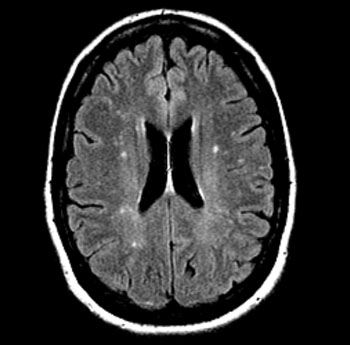MRI Study Shows Migraines with Aura Unrelated to Brain Anomalies
|
By MedImaging International staff writers Posted on 19 May 2016 |

Image: Increased white matter in migraine headache (Photo courtesy of Medscape).
A new magnetic resonance imaging (MRI) study found no association between silent brain infarcts or white matter hyperintensities (WMHs) and migraines with aura.
Researchers at Odense University Hospital (OUH; Denmark) and the University of Southern Denmark (SDU; Odense, Denmark) conducted a population-based study to identify the relationship between silent brain infarcts, WMHs, and migraine. Via the Danish Twin Registry, they identified 172 twins (30-60 years of age) with migraine with aura and 34 co-twins who, unlike their participating twin sisters, did not suffer from migraine with aura. A further 139 twins served as controls.
Based on questionnaire responses, the twins were invited to participate in a telephone-based interview. Women with migraine with aura, their co-twins, and unrelated migraine-free twins were invited to a brain MRI scan, which was assessed for the presence of infarcts and WMHs, and blinded to headache diagnoses. The results showed no differences between women with migraine with aura and those without, with regard to number of silent infarcts and WMHs. The study was published on May 3, 2016, in Brain.
“We found no evidence of an association between migraine with aura and silent brain infarcts or white matter hyperintensities,” said lead author David Gaist, MD, of OHU and SDU. “This held true for the main analyses comparing cases with unrelated controls, and for analyses focusing on twin pairs where one twin suffered from migraine with aura, and the other did not. We believe patients suffering from migraines with aura and their physicians should find these results reassuring.”
Migraine is a common disorder afflicting about 10–15% of the population. One-third of migraineurs experience transient neurological symptoms known as auras. Population-based studies have indicated that migraine, and in particular migraine with aura, may be a risk factor for subclinical (silent) brain infarcts and WMHs, which have been associated with an increased risk of stroke, dementia, and death. This raised the question whether migraine, a condition so common as to be encountered by all physicians regardless of specialty, is a chronic progressive brain disorder.
Related Links:
Odense University Hospital
University of Southern Denmark
Researchers at Odense University Hospital (OUH; Denmark) and the University of Southern Denmark (SDU; Odense, Denmark) conducted a population-based study to identify the relationship between silent brain infarcts, WMHs, and migraine. Via the Danish Twin Registry, they identified 172 twins (30-60 years of age) with migraine with aura and 34 co-twins who, unlike their participating twin sisters, did not suffer from migraine with aura. A further 139 twins served as controls.
Based on questionnaire responses, the twins were invited to participate in a telephone-based interview. Women with migraine with aura, their co-twins, and unrelated migraine-free twins were invited to a brain MRI scan, which was assessed for the presence of infarcts and WMHs, and blinded to headache diagnoses. The results showed no differences between women with migraine with aura and those without, with regard to number of silent infarcts and WMHs. The study was published on May 3, 2016, in Brain.
“We found no evidence of an association between migraine with aura and silent brain infarcts or white matter hyperintensities,” said lead author David Gaist, MD, of OHU and SDU. “This held true for the main analyses comparing cases with unrelated controls, and for analyses focusing on twin pairs where one twin suffered from migraine with aura, and the other did not. We believe patients suffering from migraines with aura and their physicians should find these results reassuring.”
Migraine is a common disorder afflicting about 10–15% of the population. One-third of migraineurs experience transient neurological symptoms known as auras. Population-based studies have indicated that migraine, and in particular migraine with aura, may be a risk factor for subclinical (silent) brain infarcts and WMHs, which have been associated with an increased risk of stroke, dementia, and death. This raised the question whether migraine, a condition so common as to be encountered by all physicians regardless of specialty, is a chronic progressive brain disorder.
Related Links:
Odense University Hospital
University of Southern Denmark
Latest MRI News
- Novel Imaging Approach to Improve Treatment for Spinal Cord Injuries
- AI-Assisted Model Enhances MRI Heart Scans
- AI Model Outperforms Doctors at Identifying Patients Most At-Risk of Cardiac Arrest
- New MRI Technique Reveals Hidden Heart Issues
- Shorter MRI Exam Effectively Detects Cancer in Dense Breasts
- MRI to Replace Painful Spinal Tap for Faster MS Diagnosis
- MRI Scans Can Identify Cardiovascular Disease Ten Years in Advance
- Simple Brain Scan Diagnoses Parkinson's Disease Years Before It Becomes Untreatable
- Cutting-Edge MRI Technology to Revolutionize Diagnosis of Common Heart Problem
- New MRI Technique Reveals True Heart Age to Prevent Attacks and Strokes
- AI Tool Predicts Relapse of Pediatric Brain Cancer from Brain MRI Scans
- AI Tool Tracks Effectiveness of Multiple Sclerosis Treatments Using Brain MRI Scans
- Ultra-Powerful MRI Scans Enable Life-Changing Surgery in Treatment-Resistant Epileptic Patients
- AI-Powered MRI Technology Improves Parkinson’s Diagnoses
- Biparametric MRI Combined with AI Enhances Detection of Clinically Significant Prostate Cancer
- First-Of-Its-Kind AI-Driven Brain Imaging Platform to Better Guide Stroke Treatment Options
Channels
Radiography
view channel
X-Ray Breakthrough Captures Three Image-Contrast Types in Single Shot
Detecting early-stage cancer or subtle changes deep inside tissues has long challenged conventional X-ray systems, which rely only on how structures absorb radiation. This limitation keeps many microstructural... Read more
AI Generates Future Knee X-Rays to Predict Osteoarthritis Progression Risk
Osteoarthritis, a degenerative joint disease affecting over 500 million people worldwide, is the leading cause of disability among older adults. Current diagnostic tools allow doctors to assess damage... Read moreUltrasound
view channel
Ultrasound Probe Images Entire Organ in 4D
Disorders of blood microcirculation can have devastating effects, contributing to heart failure, kidney failure, and chronic diseases. However, existing imaging technologies cannot visualize the full network... Read more
Disposable Ultrasound Patch Performs Better Than Existing Devices
Wearable ultrasound devices are widely used in diagnostics, rehabilitation monitoring, and telemedicine, yet most existing models rely on lead-based piezoelectric ceramics that pose health and environmental risks.... Read moreNuclear Medicine
view channel
PET Imaging of Inflammation Predicts Recovery and Guides Therapy After Heart Attack
Acute myocardial infarction can trigger lasting heart damage, yet clinicians still lack reliable tools to identify which patients will regain function and which may develop heart failure.... Read more
Radiotheranostic Approach Detects, Kills and Reprograms Aggressive Cancers
Aggressive cancers such as osteosarcoma and glioblastoma often resist standard therapies, thrive in hostile tumor environments, and recur despite surgery, radiation, or chemotherapy. These tumors also... Read more
New Imaging Solution Improves Survival for Patients with Recurring Prostate Cancer
Detecting recurrent prostate cancer remains one of the most difficult challenges in oncology, as standard imaging methods such as bone scans and CT scans often fail to accurately locate small or early-stage tumors.... Read moreGeneral/Advanced Imaging
view channel
3D Scanning Approach Enables Ultra-Precise Brain Surgery
Precise navigation is critical in neurosurgery, yet even small alignment errors can affect outcomes when operating deep within the brain. A new 3D surface-scanning approach now provides a radiation-free... Read more
AI Tool Improves Medical Imaging Process by 90%
Accurately labeling different regions within medical scans, a process known as medical image segmentation, is critical for diagnosis, surgery planning, and research. Traditionally, this has been a manual... Read more
New Ultrasmall, Light-Sensitive Nanoparticles Could Serve as Contrast Agents
Medical imaging technologies face ongoing challenges in capturing accurate, detailed views of internal processes, especially in conditions like cancer, where tracking disease development and treatment... Read more
AI Algorithm Accurately Predicts Pancreatic Cancer Metastasis Using Routine CT Images
In pancreatic cancer, detecting whether the disease has spread to other organs is critical for determining whether surgery is appropriate. If metastasis is present, surgery is not recommended, yet current... Read moreImaging IT
view channel
New Google Cloud Medical Imaging Suite Makes Imaging Healthcare Data More Accessible
Medical imaging is a critical tool used to diagnose patients, and there are billions of medical images scanned globally each year. Imaging data accounts for about 90% of all healthcare data1 and, until... Read more
Global AI in Medical Diagnostics Market to Be Driven by Demand for Image Recognition in Radiology
The global artificial intelligence (AI) in medical diagnostics market is expanding with early disease detection being one of its key applications and image recognition becoming a compelling consumer proposition... Read moreIndustry News
view channel
GE HealthCare and NVIDIA Collaboration to Reimagine Diagnostic Imaging
GE HealthCare (Chicago, IL, USA) has entered into a collaboration with NVIDIA (Santa Clara, CA, USA), expanding the existing relationship between the two companies to focus on pioneering innovation in... Read more
Patient-Specific 3D-Printed Phantoms Transform CT Imaging
New research has highlighted how anatomically precise, patient-specific 3D-printed phantoms are proving to be scalable, cost-effective, and efficient tools in the development of new CT scan algorithms... Read more
Siemens and Sectra Collaborate on Enhancing Radiology Workflows
Siemens Healthineers (Forchheim, Germany) and Sectra (Linköping, Sweden) have entered into a collaboration aimed at enhancing radiologists' diagnostic capabilities and, in turn, improving patient care... Read more


















